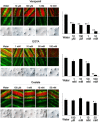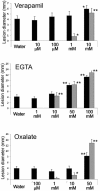Production of reactive oxygen species and wound-induced resistance in Arabidopsis thaliana against Botrytis cinerea are preceded and depend on a burst of calcium
- PMID: 24134148
- PMCID: PMC4016300
- DOI: 10.1186/1471-2229-13-160
Production of reactive oxygen species and wound-induced resistance in Arabidopsis thaliana against Botrytis cinerea are preceded and depend on a burst of calcium
Abstract
Background: Wounded leaves of Arabidopsis thaliana produce reactive oxygen species (ROS) within minutes after wounding and become resistant to the pathogenic fungus Botrytis cinerea at a local level. This fast response of the plants to the wound is called wound-induced resistance (WIR). However the molecular mechanisms of this response and the signal cascade between the wound and ROS production are still largely unknown. Calcium is a conserved signal and it is involved in many abiotic stress responses in plants, furthermore, calcium pathways act very fast.
Results: The results of this study show that leaves treated with calcium channels inhibitors (verapamil) or calcium chelators (oxalate and EGTA) are impaired in ROS production. Moreover, leaves treated with verapamil, EGTA or oxalate were more susceptible to B. cinerea after wounding. The intracellular measurements of calcium changes indicated quick but transient calcium dynamics taking place few seconds after wounding in cells neighbouring the wound site. This change in the cytosolic calcium was followed in the same region by a more stable ROS burst.
Conclusions: These data further extend our knowledge on the connection between wounding, calcium influx and ROS production. Moreover they provide for the first time the evidence that, following wounding, calcium changes precede a burst in ROS in the same location.
Figures





Similar articles
-
A permeable cuticle is associated with the release of reactive oxygen species and induction of innate immunity.PLoS Pathog. 2011 Jul;7(7):e1002148. doi: 10.1371/journal.ppat.1002148. Epub 2011 Jul 28. PLoS Pathog. 2011. PMID: 21829351 Free PMC article.
-
Wounding of Arabidopsis leaves causes a powerful but transient protection against Botrytis infection.Plant J. 2008 Aug;55(4):555-67. doi: 10.1111/j.1365-313X.2008.03540.x. Epub 2008 Apr 30. Plant J. 2008. PMID: 18452590
-
Wounding induces local resistance but systemic susceptibility to Botrytis cinerea in pepper plants.J Plant Physiol. 2015 Mar 15;176:202-9. doi: 10.1016/j.jplph.2014.12.013. Epub 2015 Jan 13. J Plant Physiol. 2015. PMID: 25662842
-
Oxidative burst and plant disease resistance.Front Biosci (Elite Ed). 2009 Jun 1;1(1):142-52. doi: 10.2741/E14. Front Biosci (Elite Ed). 2009. PMID: 19482632 Review.
-
Integration of long-range signals in plants: A model for wound-induced Ca2+, electrical, ROS, and glutamate waves.Curr Opin Plant Biol. 2022 Oct;69:102270. doi: 10.1016/j.pbi.2022.102270. Epub 2022 Aug 1. Curr Opin Plant Biol. 2022. PMID: 35926395 Review.
Cited by
-
The Arabidopsis ATP-BINDING CASSETTE Transporter ABCB21 Regulates Auxin Levels in Cotyledons, the Root Pericycle, and Leaves.Front Plant Sci. 2019 Jun 19;10:806. doi: 10.3389/fpls.2019.00806. eCollection 2019. Front Plant Sci. 2019. PMID: 31275345 Free PMC article.
-
Proteomic analysis of injured storage roots in cassava (Manihot esculenta Crantz) under postharvest physiological deterioration.PLoS One. 2017 Mar 24;12(3):e0174238. doi: 10.1371/journal.pone.0174238. eCollection 2017. PLoS One. 2017. PMID: 28339481 Free PMC article.
-
Cellular Ca2+ Signals Generate Defined pH Signatures in Plants.Plant Cell. 2018 Nov;30(11):2704-2719. doi: 10.1105/tpc.18.00655. Epub 2018 Oct 29. Plant Cell. 2018. PMID: 30377237 Free PMC article.
-
cROStalk for Life: Uncovering ROS Signaling in Plants and Animal Systems, from Gametogenesis to Early Embryonic Development.Genes (Basel). 2021 Apr 3;12(4):525. doi: 10.3390/genes12040525. Genes (Basel). 2021. PMID: 33916807 Free PMC article. Review.
-
Isoleucine Enhances Plant Resistance Against Botrytis cinerea via Jasmonate Signaling Pathway.Front Plant Sci. 2021 Aug 19;12:628328. doi: 10.3389/fpls.2021.628328. eCollection 2021. Front Plant Sci. 2021. PMID: 34489985 Free PMC article.
References
-
- Parker DM, Koller W. Cutinase and other lipolytic esterases protect bean leaves from infection by Rhizoctonia solani. Mol Plant Microbe Interact. 1998;13:514–522. doi: 10.1094/MPMI.1998.11.6.514. - DOI
-
- L'Haridon F, Besson-Bard A, Binda M, Serrano M, Abou-Mansour E, Balet F, Schoonbeek H-J, Hess S, Mir R, Leon J. et al.A permeable cuticle is associated with the release of reactive oxygen species and induction of innate immunity. PLoS Pathog. 2011;13:e1002148. doi: 10.1371/journal.ppat.1002148. - DOI - PMC - PubMed
Publication types
MeSH terms
Substances
LinkOut - more resources
Full Text Sources
Other Literature Sources

